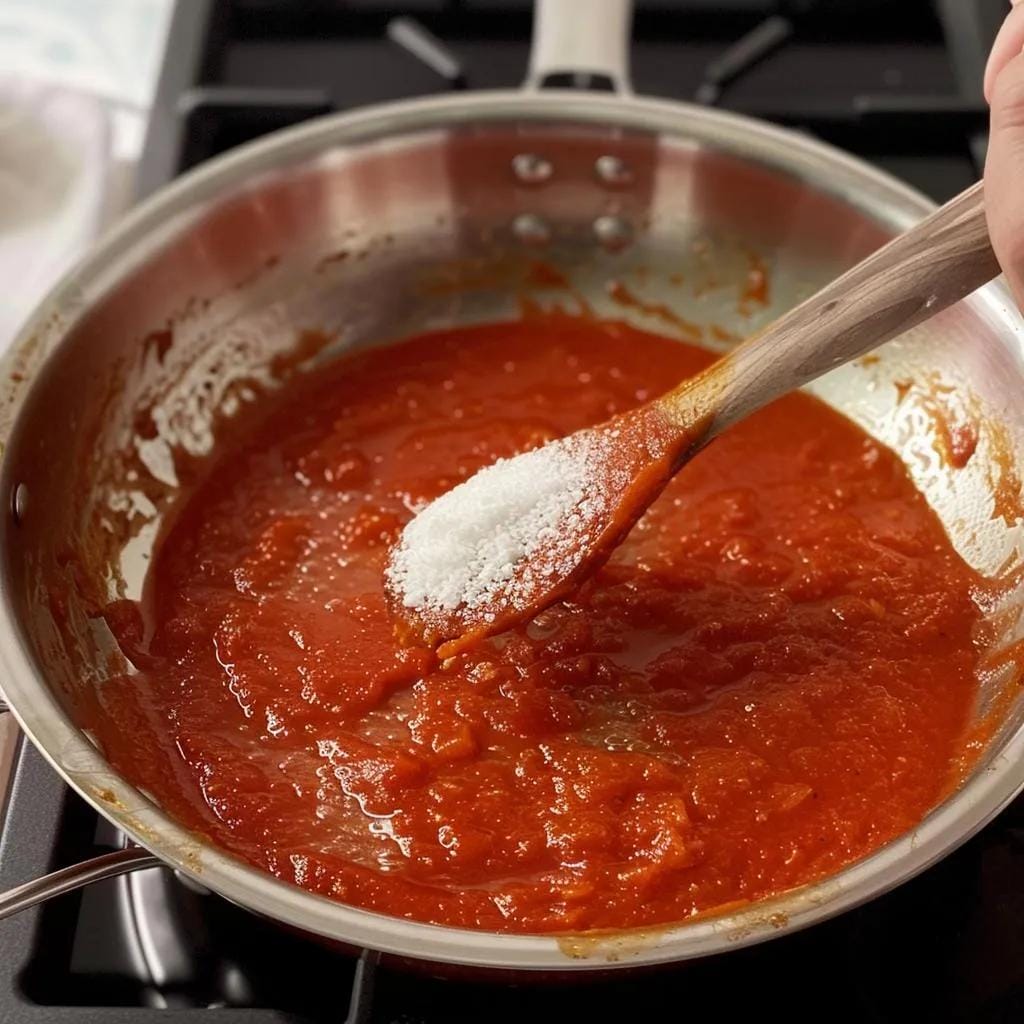Would you like to save this?
Why Add Baking Soda to Tomato Sauce?
1. Neutralizes Acidity
Tomatoes, especially when ripe, contain high levels of natural acids, which can make tomato sauce taste overly tangy or sour. Adding a small amount of baking soda to the sauce helps neutralize this acidity, resulting in a smoother, more balanced flavor. This is particularly useful when working with highly acidic tomato varieties or when the sauce is intended for dishes that benefit from a milder taste.
2. Enhances Color
The vibrant red color of tomatoes is one of their most appealing attributes, but sometimes the color can appear dull or brownish, especially after prolonged cooking. Baking soda interacts with the tomatoes to enhance their natural red hue, making the sauce look more appetizing and visually appealing.
3. Softens Texture
Baking soda helps break down the tougher fibers in tomatoes, leading to a smoother, silkier texture. This is ideal for sauces that need to be spread evenly, such as on pizzas or in delicate pasta dishes. A softer texture also makes the sauce more enjoyable to eat, without any stringy or fibrous bits.
4. Reduces Cooking Time
By breaking down cellular bonds and softening the ingredients more quickly, baking soda can significantly reduce the cooking time required to achieve a well-cooked, concentrated tomato sauce. This is a great time-saver when you’re in a hurry or when you want to quickly whip up a delicious meal.
Ingredients
To make a delicious tomato sauce with the benefits of baking soda, you’ll need the following ingredients:
2 tablespoons olive oil
1 medium onion, finely chopped
2 cloves garlic, minced
2 cans (28 oz each) crushed tomatoes
1 teaspoon salt
1 teaspoon sugar
1 teaspoon dried oregano
1/2 teaspoon dried basil
1/4 teaspoon red pepper flakes (optional)
1/4 teaspoon baking soda
Freshly ground black pepper to taste
1/4 cup chopped fresh basil (optional)
Grated Parmesan cheese for serving (optional)
Instructions
Step 1: Prepare Your Ingredients
Before you start cooking, make sure all your ingredients are prepped and ready to go. Finely chop the onion and mince the garlic. Having everything prepared in advance will make the cooking process smoother and more efficient.
Step 2: Sauté the Aromatics
Heat the Olive Oil:
In a large saucepan or Dutch oven, heat the olive oil over medium heat until it shimmers.
Add the Onion: Add the finely chopped onion to the pan and sauté for about 5 minutes, or until the onion is soft and translucent. Stir occasionally to prevent burning.
Add the Garlic: Stir in the minced garlic and cook for an additional 1-2 minutes, or until the garlic is fragrant. Be careful not to let the garlic burn, as it can become bitter.
Step 3: Combine Tomatoes and Seasonings
Add the Crushed Tomatoes:
Pour the crushed tomatoes into the pan with the sautéed onions and garlic. Stir to combine.
Season the Sauce: Add the salt, sugar, dried oregano, dried basil, and red pepper flakes (if using) to the tomato mixture. Stir well to ensure all the seasonings are evenly distributed.
Step 4: Incorporate Baking Soda
Add Baking Soda:
Sprinkle the baking soda over the tomato sauce. You will notice that the sauce will start to bubble and foam slightly. This is a normal reaction as the baking soda neutralizes the acidity of the tomatoes.
Stir the Sauce: Stir the sauce thoroughly to incorporate the baking soda evenly. Continue to cook the sauce over medium heat, allowing it to simmer gently. The foaming will subside after a few minutes.
Step 5: Simmer and Adjust
Simmer the Sauce:
Reduce the heat to low and let the sauce simmer for about 20-30 minutes, stirring occasionally. This allows the flavors to meld and the sauce to thicken. If the sauce becomes too thick, you can add a small amount of water or broth to reach your desired consistency.
Taste and Adjust Seasonings: Taste the sauce and adjust the seasonings as needed. Add freshly ground black pepper to taste. If the sauce is still too acidic, you can add a pinch more baking soda, but be careful not to overdo it.
Step 6: Finishing Touches
Add Fresh Basil (Optional):
If using fresh basil, stir it into the sauce just before serving. This adds a burst of fresh flavor and a lovely aroma.
Serve: Serve the tomato sauce over your favorite pasta, or use it as a base for pizza, lasagna, or any other dish that calls for tomato sauce. Top with grated Parmesan cheese if desired.
Variations and Substitutions
Meat Lovers:
For a heartier sauce, add cooked ground beef, Italian sausage, or meatballs to the tomato sauce.
Vegetarian Delight: Add diced vegetables such as bell peppers, zucchini, or mushrooms to the sauce for extra flavor and nutrition.
Herb Infusion: Experiment with different herbs like thyme, rosemary, or bay leaves to customize the flavor profile of your sauce.
Wine Addition: For an added depth of flavor, deglaze the pan with a splash of red wine before adding the crushed tomatoes.
Conclusion
Adding baking soda to tomato sauce may seem unconventional, but it offers several benefits that can enhance the flavor, color, and texture of your sauce. This simple trick helps neutralize the acidity of tomatoes, making the sauce smoother and more balanced. It also improves the color, softens the texture, and can even reduce cooking time. By following the detailed steps and tips provided in this guide, you can create a delicious, homemade tomato sauce that will impress your family and friends. Whether you’re a seasoned cook or a kitchen novice, this technique is sure to elevate your tomato sauce to new heights. Enjoy the improved flavor and quality of your sauce, and delight in the compliments you’ll receive from those lucky enough to taste it!







